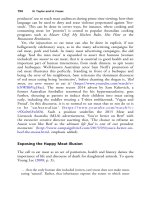The palgrave international handbook of a 477
Bạn đang xem bản rút gọn của tài liệu. Xem và tải ngay bản đầy đủ của tài liệu tại đây (28.9 KB, 1 trang )
Animals in War
479
Perhaps these factors were less significant in the early skirmishes, or small
conflicts, that Anthony postulates at the origin of horse domestication, but as
war became more and more systematized, conflicts intensified, distances
traveled grew, and challenges were magnified. Techniques, strategies, tools
—all hinged on the omnipresence of the horse in warfare. As DiMarco notes
in the opening of his book, horses ‘were a key to the success of Alexander the
Great in the fourth century BC, and, likewise, were integral to British
General Edmund Allenby’s successful Palestine campaign in the same part
of the world 2,200 years later’ (2008, p. ix). DiMarco underscores the
surprising fact that ‘the similarities’ of these forces ‘were far greater than
their differences’ (2008, p. ix). To gain some sense of this history, I first offer
a brief account of the evolution of roles for horses in war and then turn to
more recent history, which presents a somewhat clearer picture of horse
activities. Horses receive the fullest treatment in this chapter because they
have been so essential to the history of war.
The specific roles horses performed in war shortly after domestication
remain less clear, but indications of forms of their use grow increasingly
certain in time. As Clutton-Brock notes, we find pictographs from modernday Iraq with boxes attached to wheels or sleds that would be drawn by
horses or oxen, dating to 3200–3100 BCE (1992, p. 68). And Keegan
recognizes that in Ur, which is modern-day Iraq, there is clear evidence on
The Standard of Ur of use of onagers—large donkeys—to pull fourwheeled carts in war by about 2500 BCE (1993, p. 157; also see
DiMarco 2008, pp. 3, 5, figure, and see note 9, 361). These four-wheeled
carts became two-wheeled chariots, which, along with horses, Keegan
writes, ‘were truly to revolutionize warmaking, above all by putting the
rich and stable but sedentary valley civilizations at risk from the predators
who hovered in the horse-breeding lands beyond’ (1993, p. 136). DiMarco
writes, ‘The technology for the two-wheeled war chariot migrated in all
directions [ . . . ]’. It became ‘the standard of advanced military technology’
and would remain so for 600 years (1993, p. 4). What did the horses
experience in these scenarios? In the Middle East, a document for the
training of horses by Kikkuli suggests thoughtful treatment of the animals.
Their diet is described, and they ‘were gently broken to the task of chariot
driving’ (DiMarco 2008, p. 5). We also know war exposed horses to injury.
This is common sense, but it is also demonstrated by the development and
use of armor. Whole elements of these cultures revolved around protecting
horses exposed to danger in war, since often the horse was the most
vulnerable component of their warring systems (DiMarco 2008, p. 6).
The very usefulness and value of horses led to their grave vulnerability.









